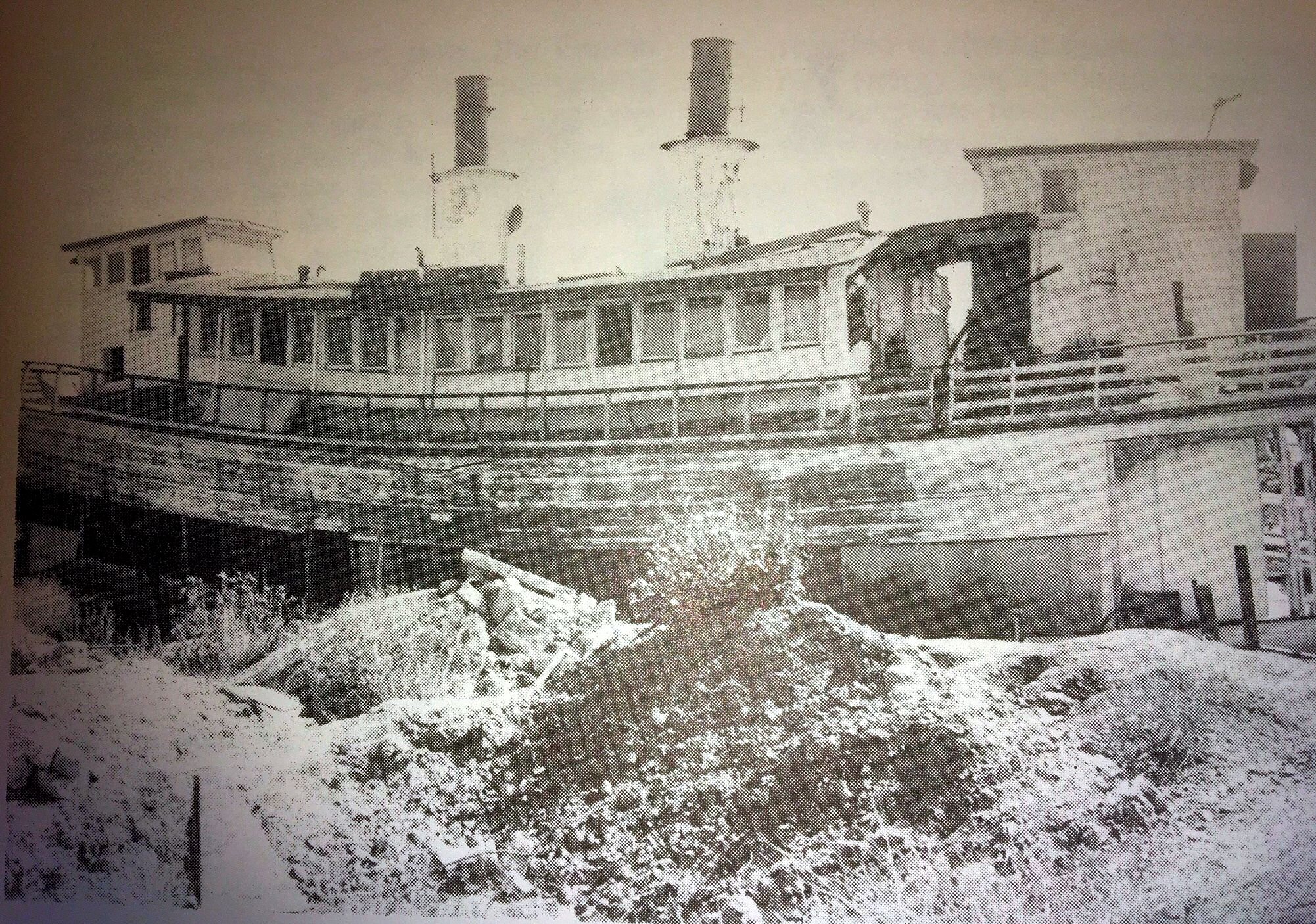By Annie Sutter and Larry Clinton, Sausalito Historical Society
Most people know that Issaquah Dock at Waldo Point Harbor is named after an old ferryboat. Annie Sutter tells the story of that long-gone waterfront relic in her 1987 booklet, The Old Ferryboats of Sausalito:
PHOTO FROM ANNIE SUTTER
Old “Squash” almost looks squashed in this Marin Scope photo
The Issaquah was described by those who knew her in service as "the sweetest little ferry that ever was." Known as "Squash," the 114' propeller driven double ender was built in Puget Sound in 1914. In 1918 the little steamer was purchased by the newly formed Rodeo/Vallejo line, and the new owner brought her down the coast to San Francisco Bay under her own power. Although "Squash" and the crew were severely knocked about by a storm on the way down, she was put to work immediately upon arrival on July 4, 1918. In 1927 the opening of the Carquinez Bridge put the line out of business — a taste of what was to come — and the Issaquah moved over to the Martinez/Benecia run until 1941 when she went to work on Mare Island/Vallejo service, and then was laid up after the war at Vallejo.
Issaquah remained retired until 1954 when Sausalito artist Jean Varda bought her for his young Greek bride and brought her to Sausalito. But the bride apparently did not appreciate the gift, and after a couple of years the pretty little ferry sold and resold again. There were various plans — a night¬club, a developer's office, a restaurant — there were bursts of enthusiasm and subsequent burnouts over the years; claims, counterclaims and liens, problems which seem to have beset all the old ferries as time went on. In the late 50's the boat was divided into living quarters and rented out to tenants, but by then she had begun to hog, and teredos had bored through the hull.
Most of the tenants on board the Issaquah apparently — and not unreasonably — were unwilling to invest the tremendous amounts of time and money involved in keeping even with the disintegration. But one used his head instead of his energy to get the ferry a facelift, by allowing a movie company to use her in a film in exchange for a new paint job. And paint her they did, but only the side they were filming. And when the cameras began to roll, a banner saying things about the cheap movie company unfurled from the upper deck. Issaquah got the other half of the paint job.
But desultory maintenance isn't enough. Deal only with the surface and you've got but a brief respite, an impermanent truce in the endless battle waged on board the ferries with time, worms, weathering and rot. Both ferries at the edge of the freeway will have to be saved soon — if indeed it is still possible. Why did it happen? Whose fault is it that we are losing these representatives of an important part of our maritime history?
"Blame the corporations that sold them," said the salvor. "They should've cared enough to sell them to someone willing to maintain them, not someone like me."
"But," said the old timer, "old and tired ferry boats were a dime a dozen in those days. Who knew how quickly they would become objects of historical value?"
"Go take pictures of them," said the historian, "for soon that's all you'll have left. Everybody had something that's lost now — if we knew it would have value someday, why we'd have a fortune."
"Blame the people who lived on board. Why couldn't they pick up a paintbrush once a year? They just wanted a pad, and they were too lazy to put a 2 x 4 under a sagging timber."
"Blame [landlord Donovan] Arques. He wouldn't ever turn those boats over to anybody, why should they do all the work when they don't even own it?"
And on go the arguments; blame time, blame teredos, blame the irreconcilable distances between what you think you want and what you're willing to put together. Blame the myriad circumstances waiting to contribute to our roster of historical losses.
According to Wikipedia, the movie mentioned above was "Dear Brigitte" starring Jimmy Stewart. “Squash’s” good side can be seen beached on the mud behind the Charles van Damme.
In the 1970s the two pilot houses were salvaged from the mud flats and restored. They are the sole remnants of the vessel and are displayed at the foot of Napa Street, in Galilee Harbor.

